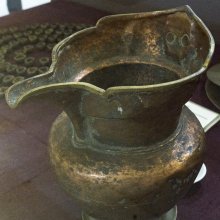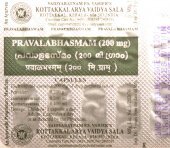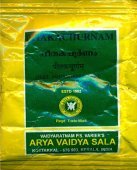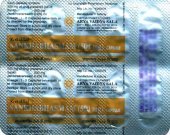Ghi, Ghī, Ghee: 16 definitions
Introduction:
Ghi means something in Buddhism, Pali, Hinduism, Sanskrit, Marathi, Jainism, Prakrit, Hindi, biology. If you want to know the exact meaning, history, etymology or English translation of this term then check out the descriptions on this page. Add your comment or reference to a book if you want to contribute to this summary article.
Images (photo gallery)
In Hinduism
Ayurveda (science of life)
Rasashastra (Alchemy and Herbo-Mineral preparations)
Source: archive.org: Rasa-Jala-Nidhi: Or Ocean of indian chemistry and alchemyGhee refers to “clarified butter”. (see Bhudeb Mookerji and his Rasajalanidhi)
Veterinary Medicine (The study and treatment of Animals)
Source: Asian Agri-History: Paśu Āyurvēda (Veterinary Medicine) in GaruḍapurāṇaGhee (is Sanskrit: ghṛta, ājya) is used in the protection rites of Horses (Aśvarakṣaṇa), according to Āyurveda sections in the Garuḍapurāṇa.—For the Rakṣa (protection) Revanta-pūjā, (worship of God Revanta) homa (sacrificial offerings) and dvija-bhojana (feeding of Brahmins) should be performed in favor of the horse. And a compound made up of following drugs should be tied round the neck of the horse [e.g., ghṛta (ghee)] [...].

Āyurveda (आयुर्वेद, ayurveda) is a branch of Indian science dealing with medicine, herbalism, taxology, anatomy, surgery, alchemy and related topics. Traditional practice of Āyurveda in ancient India dates back to at least the first millenium BC. Literature is commonly written in Sanskrit using various poetic metres.
Vyakarana (Sanskrit grammar)
Source: Wikisource: A dictionary of Sanskrit grammar1) Ghi (घि).—A tech. term applied to noun bases or Prātipadikas ending in इ (i) and उ (u) excepting the words सखि (sakhi) and पति (pati) and those which are termed नदी (nadī); cf. P. I. 4.79;
2) Ghi.—A conventional term for लधु (ladhu) (a short vowel) found used in the Jainendra Vyakarana.

Vyakarana (व्याकरण, vyākaraṇa) refers to Sanskrit grammar and represents one of the six additional sciences (vedanga) to be studied along with the Vedas. Vyakarana concerns itself with the rules of Sanskrit grammar and linguistic analysis in order to establish the correct context of words and sentences.
Natyashastra (theatrics and dramaturgy)
Source: Shodhganga: Elements of Art and Architecture in the Trtiyakhanda of the Visnudharmottarapurana (natya)Ghee (i.e., greasy substances) is associated with Catura-hasta: one of the twenty-two Single-hand Gestures (in Indian Dramas) (known as asaṃyuktahastas), according to the Viṣṇudharmottarapurāṇa, an ancient Sanskrit text which (being encyclopedic in nature) deals with a variety of cultural topics such as arts, architecture, music, grammar and astronomy.—According to the Viṣṇudharmottarapurāṇa, some colours are pointed with the catura hand gesture. [...] Instead of showing colours, in the Abhinayadarpaṇa, the caturahasta posture denotes some metals like gold, copper and iron. This posture also shows the application of some greasy substances like oil, ghee etc on the face

Natyashastra (नाट्यशास्त्र, nāṭyaśāstra) refers to both the ancient Indian tradition (shastra) of performing arts, (natya—theatrics, drama, dance, music), as well as the name of a Sanskrit work dealing with these subjects. It also teaches the rules for composing Dramatic plays (nataka), construction and performance of Theater, and Poetic works (kavya).
Vastushastra (architecture)
Source: Shodhganga: Elements of Art and Architecture in the Trtiyakhanda of the Visnudharmottarapurana (vastu)Ghee and Honey are used to clean the axe during the cutting of trees for the purpose of gathering Material for the Construction of Temples, according to the Viṣṇudharmottarapurāṇa, an ancient Sanskrit text which (being encyclopedic in nature) deals with a variety of cultural topics such as arts, architecture, music, grammar and astronomy.—In the Viṣṇudharmottarapurāṇa, the architect is suggested to go to the forest to collect appropriate wood for temples in an auspicious day after taking advice from an astrologer. [...] At the time of Cutting the Trees one should clean the axe by smearing honey and ghee. After collecting the suitable wood from forest, the architect uses it according to his requirements and purposes. The eco-friendly suggestions of Viṣṇudharmottarapurāṇa are seen to protect the greenery and to balance a pollution free environment.

Vastushastra (वास्तुशास्त्र, vāstuśāstra) refers to the ancient Indian science (shastra) of architecture (vastu), dealing with topics such architecture, sculpture, town-building, fort building and various other constructions. Vastu also deals with the philosophy of the architectural relation with the cosmic universe.
Yoga (school of philosophy)
Source: ORA: Amanaska (king of all yogas): A Critical Edition and Annotated Translation by Jason BirchGhee can denoted by the Sanskrit termss Ghṛta or Sarpis, according to the Amanaska Yoga treatise dealing with meditation, absorption, yogic powers and liberation.—Accordingly, as Īśvara says to Vāmadeva: “[...] [Now], I shall define the nature of that highest, mind-free absorption which arises for those devoted to constant practice. [...] Just as ghee (ghṛta) which has dissolved into [another batch of] ghee, is not separate [in any way] from [that] ghee, so the Yogin, who has dissolved into the highest reality, is not aware of separateness. [...]”.

Yoga is originally considered a branch of Hindu philosophy (astika), but both ancient and modern Yoga combine the physical, mental and spiritual. Yoga teaches various physical techniques also known as āsanas (postures), used for various purposes (eg., meditation, contemplation, relaxation).
General definition (in Hinduism)
Source: archive.org: Village folk-tales of Ceylonliquid butter;
Source: WikiPedia: HinduismGhee is a class of clarified butter that originated in South Asia and is commonly used in South Asian (Indian, Bangladeshi, Nepali and Pakistani) cuisine and ritual.
The word ghee comes from Sanskrit: घृत (ghṛta, 'sprinkled') and has several names around the world
- Bengali: ঘী ghee,
- Punjabi: ਘਿਉ ghyo,
- Hindi: घी ghī,
- Gujarati: ઘી ghī,
- Maithili/ Nepali: घ्यू ghyū,
- Urdu: گھی ghī,
- Oriya: ଘିଅ gheeo,
- Marathi/Konkani: तूप tūp,
- Kannada: ತುಪ್ಪ tuppa,
- Malayalam: നെയ്യ് ney,
- Tamil: நெய் ney,
- Telugu: నెయ్యి neyyi,
- Somali: subaag,
- Arabic: سمنة samna,
- Persian: روغن حیوانی roghan-e heivani,
- Georgian: ერბო erbo,
- Indonesian: minyak samin,
- Malay: minyak sapi,
- Hausa: man shanu
In Buddhism
General definition (in Buddhism)
Source: Wisdom Library: BuddhismGhee:—The highest grade of clarified butter. Ghee was often used as an example of something that was the finest or best it could possibly be.
Biology (plants and animals)
Source: Google Books: CRC World Dictionary (Regional names)1) Ghee in India is the name of a plant defined with Podophyllum emodi in various botanical sources. This page contains potential references in Ayurveda, modern medicine, and other folk traditions or local practices It has the synonym Sinopodophyllum hexandrum (Royle) T.S. Ying var. emodi (Wall., Hook.f. & Thomson) J.M.H. Shaw (among others).
2) Ghee is also identified with Sinopodophyllum hexandrum It has the synonym Podophyllum sikkimensis Chatterjee & Mukerjee (etc.).
Example references for further research on medicinal uses or toxicity (see latin names for full list):
· Illustrations of the Botany … of the Himalayan Mountains (1834)
· Acta Botanica Boreali-Occidentalia Sinica (1996)
· Records of the Botanical Survey of India (1953)
· Glimpses Pl. Res. (1998)
· Genetica (1990)
· Beaut. Fl. Kash. (1928)
If you are looking for specific details regarding Ghee, for example chemical composition, diet and recipes, health benefits, pregnancy safety, extract dosage, side effects, have a look at these references.

This sections includes definitions from the five kingdoms of living things: Animals, Plants, Fungi, Protists and Monera. It will include both the official binomial nomenclature (scientific names usually in Latin) as well as regional spellings and variants.
Languages of India and abroad
Marathi-English dictionary
Source: DDSA: The Molesworth Marathi and English DictionaryGhī (घी).—n ( H) Clarified butter, ghee. This word, though well known, is little used by Maraṭha people. Pr. ghī gayā para kupā tō gayā nahīṃ A Hindustani proverb but common. The ghee may be gone, but the bottle remains. Used in hinting to one who is making some false assertion, that, though the matter be past, all documents respecting it are not lost.
Source: DDSA: The Aryabhusan school dictionary, Marathi-EnglishGhī (घी).—n Clarified butter, ghee.
Marathi is an Indo-European language having over 70 million native speakers people in (predominantly) Maharashtra India. Marathi, like many other Indo-Aryan languages, evolved from early forms of Prakrit, which itself is a subset of Sanskrit, one of the most ancient languages of the world.
Hindi dictionary
Source: DDSA: A practical Hindi-English dictionaryGhī (घी) [Also spelled ghee]:—(nm) ghee; —[ke cirāga/die jalānā] lit. to light up ghee lamps -to celebrate (the fulfilment of some cherished desire) by fanfare/merry-making/festivity; —[khicaḍi/śakkara honā] to be hand in glove with; to be in intimate association; to become inseparably united; —[dūdha kī nadī bahanā] to be very prosperous and affluent.
Source: DDSA: A practical Hindi-English dictionaryGhee in Hindi refers in English to:—(nm) ghee; —[ke ciraga/die jalana] lit. to light up ghee lamps -to celebrate (the fulfilment of some cherished desire) by fanfare/merry-making/festivity; —[khicadi/shakkara hona] to be hand in glove with; to be in intimate association; to become inseparably united; —[dudha ki nadi bahana] to be very prosperous and affluent..—ghee (घी) is alternatively transliterated as Ghī.
...
Prakrit-English dictionary
Source: DDSA: Paia-sadda-mahannavo; a comprehensive Prakrit Hindi dictionaryGhi (घि) in the Prakrit language is related to the Sanskrit word: Grīṣma.
Ghi has the following synonyms: Ghiṃsu.
Prakrit is an ancient language closely associated with both Pali and Sanskrit. Jain literature is often composed in this language or sub-dialects, such as the Agamas and their commentaries which are written in Ardhamagadhi and Maharashtri Prakrit. The earliest extant texts can be dated to as early as the 4th century BCE although core portions might be older.
Nepali dictionary
Source: unoes: Nepali-English DictionaryGhee is another spelling for घिउ [ghiu].—n. purified butter; ghee;
Nepali is the primary language of the Nepalese people counting almost 20 million native speakers. The country of Nepal is situated in the Himalaya mountain range to the north of India.
See also (Relevant definitions)
Starts with (+111): Ghi kanwar, Ghia, Ghia-torai, Ghicaha, Ghicai, Ghicapica, Ghicasa, Ghiccinu, Ghiccyai, Ghiccyaunu, Ghichaaha, Ghichaai, Ghichpich, Ghichuva, Ghicimiro, Ghicnu, Ghicro, Ghicuva, Ghidaghida, Ghidaghidaunu.
Ends with (+63): Addhajaghi, Agghi, Aghi, Alaghi, Amoghi, Anghi, Audameghi, Bagghi, Baghi, Bankhanghi, Barkanghi, Basakdoghi, Bhandijanghi, Bhranghi, Bhui ringhi, Bossanghi, Dirghi, Dridhasanghi, Drumavyaghi, Ekuleghi.
Full-text (+1584): Ghrita, Sarpis, Pancamrita, Ghritakta, Ajya, Ghritapashu, Ghritaprasha, Takramamsa, Havishya, Ghritadhenu, Madhuparka, Ghritaci, Ghritakumbha, Ghritoda, Magha, Samyava, Doghe, Yupakarna, Ghritapluta, Ghritashri.
Relevant text
Search found 187 books and stories containing Ghi, Ghī, Ghee; (plurals include: Ghis, Ghīs, Ghees). You can also click to the full overview containing English textual excerpts. Below are direct links for the most relevant articles:
Rig Veda (translation and commentary) (by H. H. Wilson)
Charaka Samhita (English translation) (by Shree Gulabkunverba Ayurvedic Society)
Chapter 16 - The therapeutics of Anemia (panduroga-cikitsa) < [Cikitsasthana (Cikitsa Sthana) — Section on Therapeutics]
Chapter 18 - The therapeutics of Cough Disorder (kasa-cikitsa) < [Cikitsasthana (Cikitsa Sthana) — Section on Therapeutics]
Chapter 10 - The Pharmaceutics of the Thorny Milk-hedge Plant (sudha-kalpa) < [Kalpasthana (Kalpa Sthana) — Section on Pharmaceutics]
Folk Tales of Gujarat (and Jhaverchand Meghani) (by Vandana P. Soni)
Chapter 21 - Koyal Vrat < [Part 3 - Kankavati]
Chapter 27 - Bhe Baras—[Abhay Baras] < [Part 3 - Kankavati]
Chapter 12 - Shravaniya Somvar < [Part 3 - Kankavati]
Vasudevavijaya of Vasudeva (Study) (by Sajitha. A)
Dvandva-samāsa (Compound) < [Chapter 3 - Vāsudevavijaya—A Grammatical Study]
Kāraka (i): Karmapravacanīya < [Chapter 3 - Vāsudevavijaya—A Grammatical Study]
Dharmaśāstra (the Dharmasūtras and Smṛtis) < [Chapter 5 - Impact of other Disciplines in Vāsudevavijaya]
The Markandeya Purana (Study) (by Chandamita Bhattacharya)
Food that are not to be Stolen < [Chapter 2]
Superstitions Related to Home < [Chapter 2]
4. Harmful Results of Neglecting Rules < [Chapter 4]
Cosmetics, Costumes and Ornaments in Ancient India (by Remadevi. O.)
3.1. Use of Medicines (Introduction) < [Chapter 1 - Cosmetics]
2.2. Lower Garments (c): Tārpya (sacrificial garment) < [Chapter 2 - Costumes]
2.11. Pharmaceutical use of Incense < [Chapter 1 - Cosmetics]
Related products
(+59 more products available)






